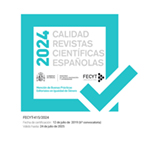Consumo cultural y preferencias: canciones escuchadas (y compartidas) en los medios digitales por jóvenes del estado brasileño más pequeño
Resumen
Este artículo pretende contribuir al estudio acerca sobre el consumo cultural de los jóvenes con un elemento que aparece a menudo en un segundo plano o ignorado. Nos referimos a cómo los jovenes brasileños gestionan sus impresiones sobre los productos de consumo en sus redes sociales. Para ello, trabajamos con el concepto de rendimiento y su formulación en el marco de los estudios sobre el gusto y las preferencias en el consumo cultural. En concreto planteamos que el intercambio de determinados contenidos en entornos digitales que promueven la creación de redes sociales se hace estratégicamente con el propósito de dar pistas acerca de los deseos individuales para poder ser percibido por sus socios y lograr de este modo una pertenencia a determinados grupos sociales -más allá de una mera preferencia personal. Presentamos el resultado de dos investigaciones sobre la recepción de ciertos productos de medios de consumo llevadas acabo en el Nordeste brasileño, en el estado de Sergipe. En estas investigaciones se aprecian preferencias y gustos diferenciados en el consumo de productos musicales por parte de los jovenes de las ciudades y los del interior.
Descargas
##plugins.generic.pfl.publicationFactsTitle##
##plugins.generic.pfl.reviewerProfiles## N/D
##plugins.generic.pfl.authorStatements##
Indexado: {$indexList}
-
##plugins.generic.pfl.indexedList##
- ##plugins.generic.pfl.academicSociety##
- N/D
- Editora:
- Grupo de Investigación Cultura Digital y Movimientos Sociales. Cibersomosaguas
Descarga artículo
Licencia
La revista Teknokultura, para fomentar el intercambio global del conocimiento, facilita el acceso sin restricciones a sus contenidos desde el momento de su publicación en la presente edición electrónica, y por eso es una revista de acceso abierto. Los originales publicados en esta revista son propiedad de la Universidad Complutense de Madrid y es obligatorio citar su procedencia en cualquier reproducción total o parcial. Todos los contenidos se distribuyen bajo una licencia de uso y distribución Creative Commons Reconocimiento 4.0 (CC BY 4.0). Esta circunstancia ha de hacerse constar expresamente de esta forma cuando sea necesario. Puede consultar la versión informativa y el texto legal de la licencia.













